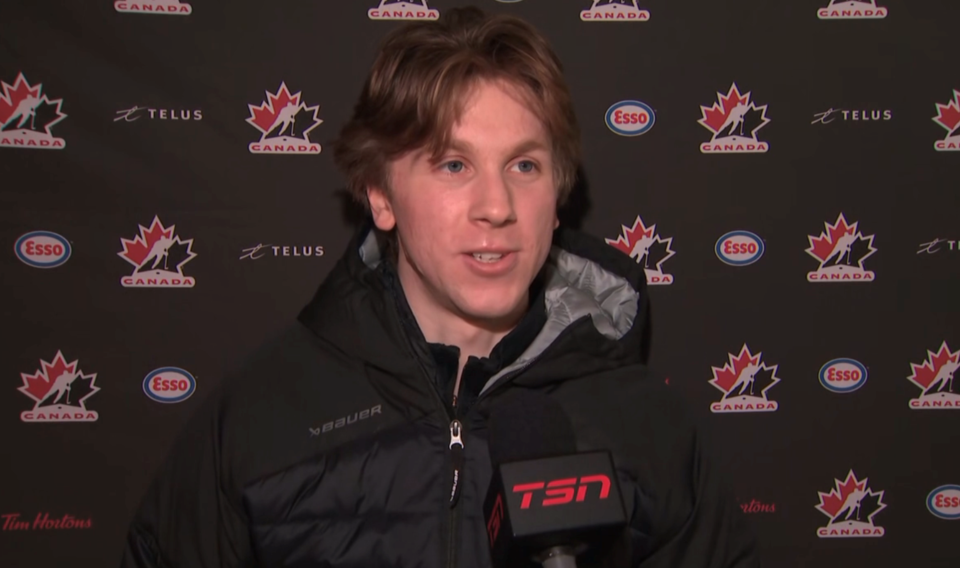The Vancouver Canucks have just one prospect remaining at the 2025 World Junior Championship after Canada's quarterfinal game against Czechia went disastrously wrong.
It was an appropriate ending for Canada's worst World Junior performance since 1998, when they won just two of seven games to finish eighth out of ten teams below Kazakhstan.
Canada won just two games in this year's tournament as well, managing to beat Finland and Germany in the preliminary round, while suffering an upset loss to Latvia and a 4-1 loss to Team USA. That meant Canada finished third in Group A and had to face a tough Czechia team in the quarterfinal.
It went wrong immediately, as Czechia opened the scoring off a neutral zone turnover in the opening minute. Then, after Canada tied up the game with a shorthanded goal after a controversial five-minute major, they gave up an embarrassing own goal when Sam Dickinson accidentally played the puck into his own net with his glove after it banked off the boards.
Canada kept shooting themselves in the foot with a bad turnover inside the Czechia blue line with just seconds remaining in the first period, allowing Eduard Sale to give Czechia a 3-1 lead heading into the first intermission.
A power play goal late in the second period gave Canada hope and then Bradly Nadeau banged in a rebound with 4:18 remaining in the third period to tie the game.
But then the same issue that hurt Canada all tournament reared its ugly head: lack of discipline. With two-and-a-half minutes remaining, Andrew Gibson took a kneeing penalty. On the subsequent power play, Adam Pecho fired a one-timer past Carter George for the game-winner to end Canada's tournament.
It was a particularly short tournament for Canucks prospect Sawyer Mynio, who was only officially added to the roster two games in and played just three games. It was Mynio's first time representing Canada at any level.
While Mynio wasn't a difference-maker at the tournament as a third-pairing defenceman, he didn't hurt the team either. In three games, he averaged just 13:04 per game in ice time, tallied one assist, and finished a plus-one at even-strength. He played a quiet, straightforward game, eliminating rushes with his mobility, protecting the middle of the ice in-zone, and transitioning the puck up ice with a good first pass.
Given his limited ice time, that's all you can really expect from Mynio. In the quarterfinal game against Czechia, Mynio wasn't on the ice for any of Czechia's four goals. He did his job.
Really, none of the players are to blame for Canada's performance at the 2025 World Juniors. That blame should go directly on Hockey Canada and the braintrust behind putting together the team.
Hockey Canada seems to build their teams as if they have to stay under an imaginary salary cap. Instead of bringing all of their best players, they fret and worry about having the right mix of scorers, grinders, penalty killers, puck-movers, and stay-at-home defencemen.
As a result, some of Canada's most talented under-20 players were left at home, like Beckett Sennecke, Michael Misa, Andrew Cristall, Zayne Parekh, and Carter Yakemchuk, among others.
In a short tournament, it's hard to bank on perfect roster construction and chemistry — assuming your roster construction is perfect to begin with. It's more about players getting hot at the right time, so bringing as many firestarters as possible is the best strategy.
Instead of worrying about players fitting into roles, trust that elite hockey players can figure out how to play in those roles; smart hockey players can figure out penalty killing even if they don't do it regularly. Honestly, most of those elite players probably already kill penalties with their club teams.
Perhaps Hockey Canada's roster strategy would make sense if their penalty killing was the best in the tournament. Instead, they gave up seven power play goals on 27 opportunities — a penalty-killing percentage of 74.1% that ranked sixth in the tournament. Those power play goals against played a major role in their record.
The real trouble was the team's offence, as they managed just 13 goals in five games, which ranked sixth in the tournament after the quarterfinal round. That's less than half the goals that Team USA, Czechia, and Sweden scored. The roster construction is therefore the biggest culprit in a disappointing tournament: they left potent offensive threats at home in favour of role players, then couldn't score and couldn't kill penalties.
Mynio wasn't one of those roster missteps, to be clear. His selection to the team was a testament to how his game has progressed since he was drafted in the third round in 2023. He's no slouch offensively, with 19 points in 18 games for the Seattle Thunderbirds this season, even if he didn't get opportunities to prove it with Team Canada.
As a left-shot defenceman, Mynio making the team had nothing to do with the right-shooting Parekh and Yakemchuk or any of the forwards getting left off the roster. In fact, Mynio was paired with Parekh during the selection camp and it looked like they might make the team together. It was not to be.
This is the second straight World Juniors with Canada getting knocked out in the quarterfinals by Czechia and finishing fifth. Will any of this wake up Hockey Canada and make them reassess how they put teams together for international tournaments? Will it further force them to change how they develop players throughout the country?
Or will the men in charge skate by without consequences as they have so many times before?



